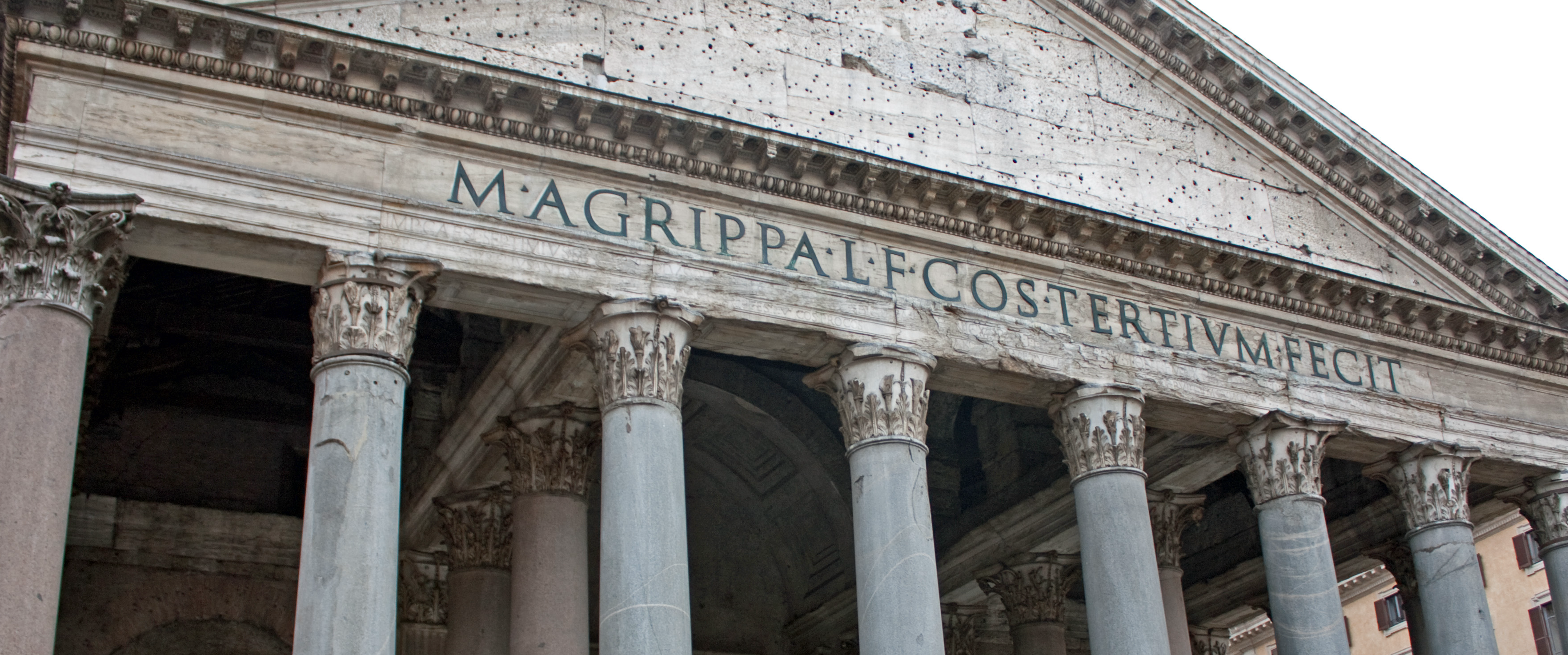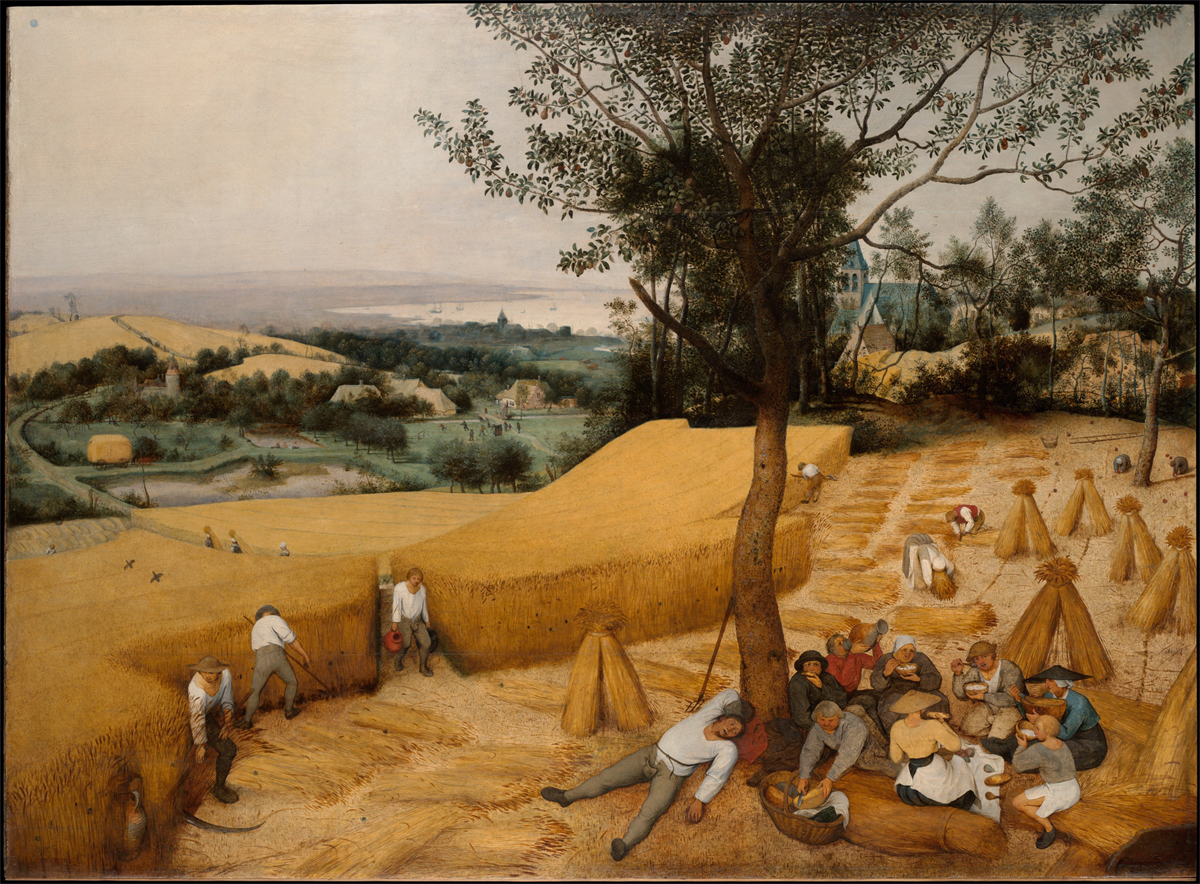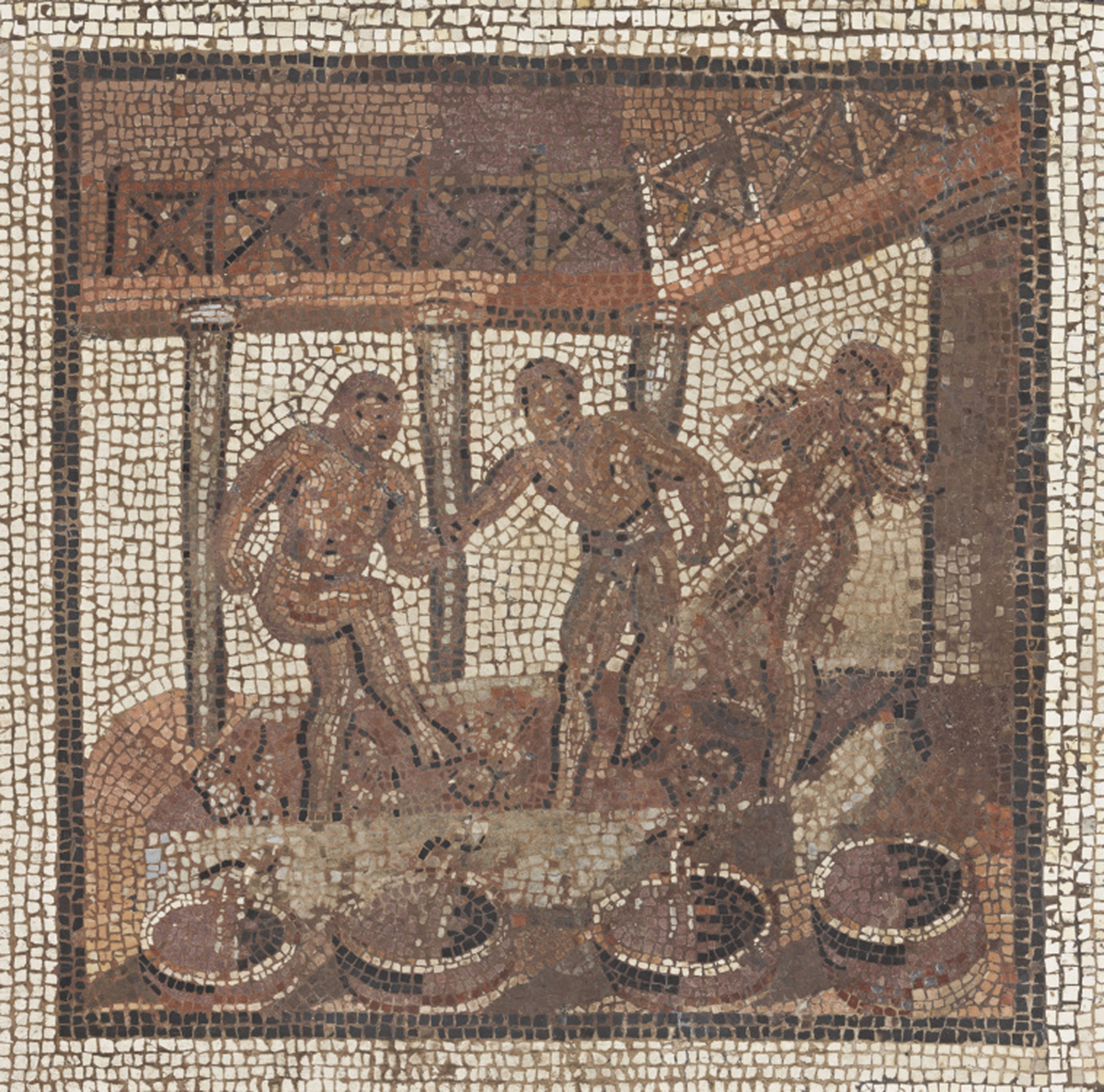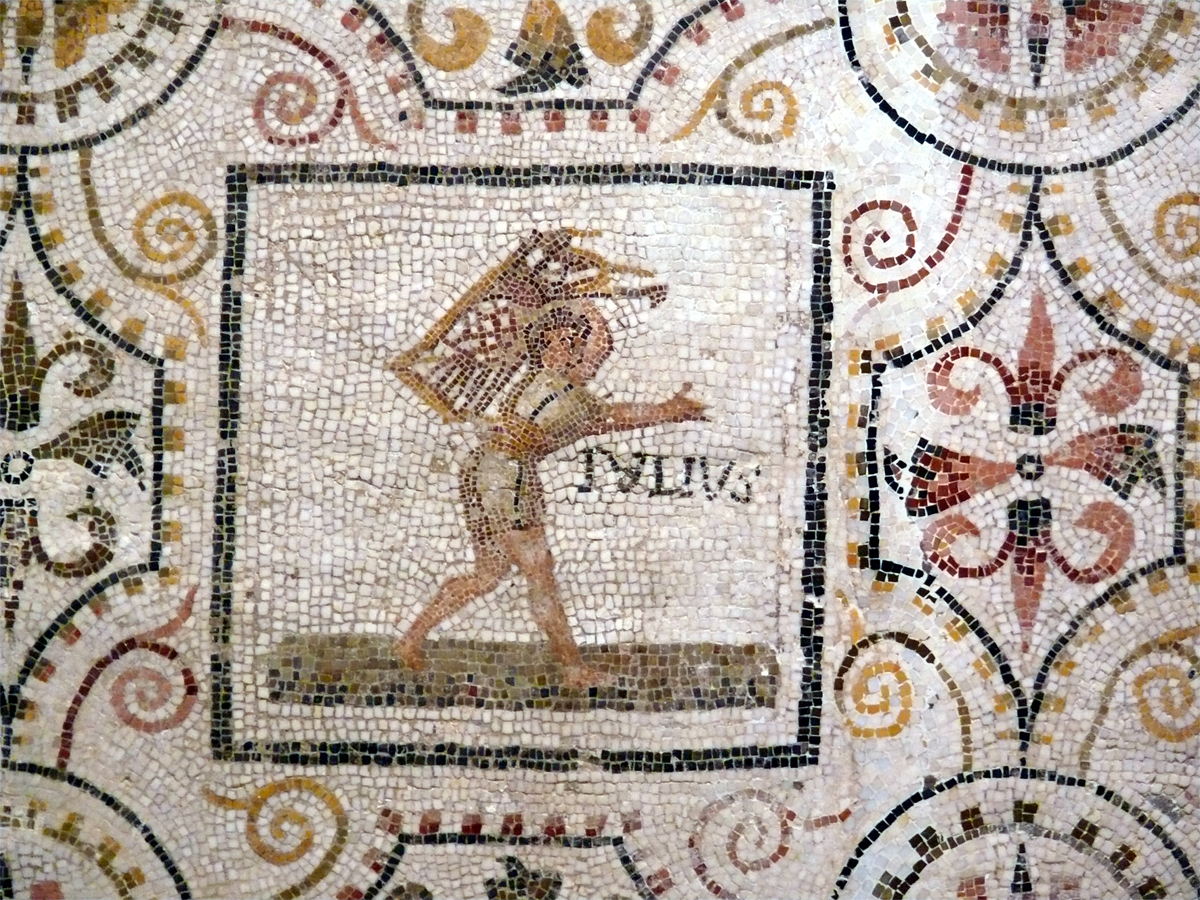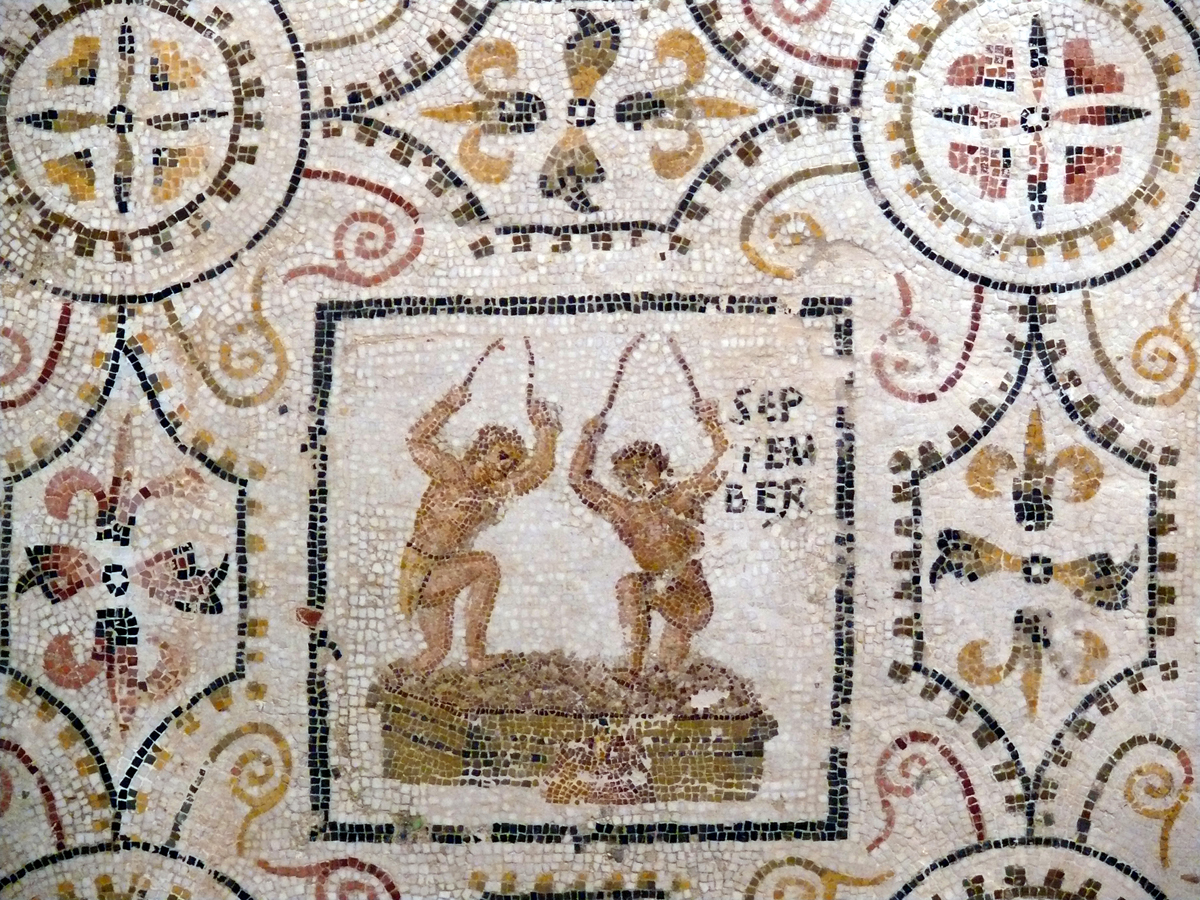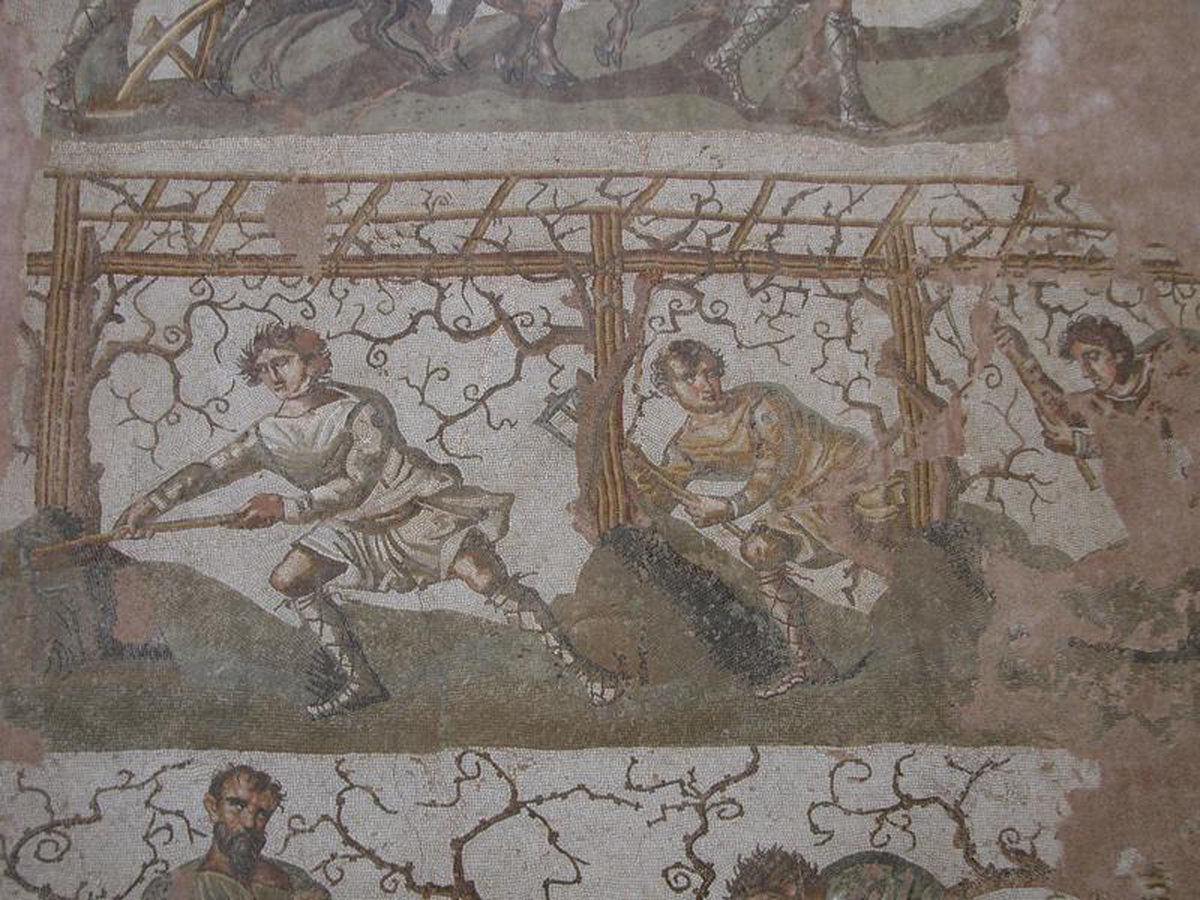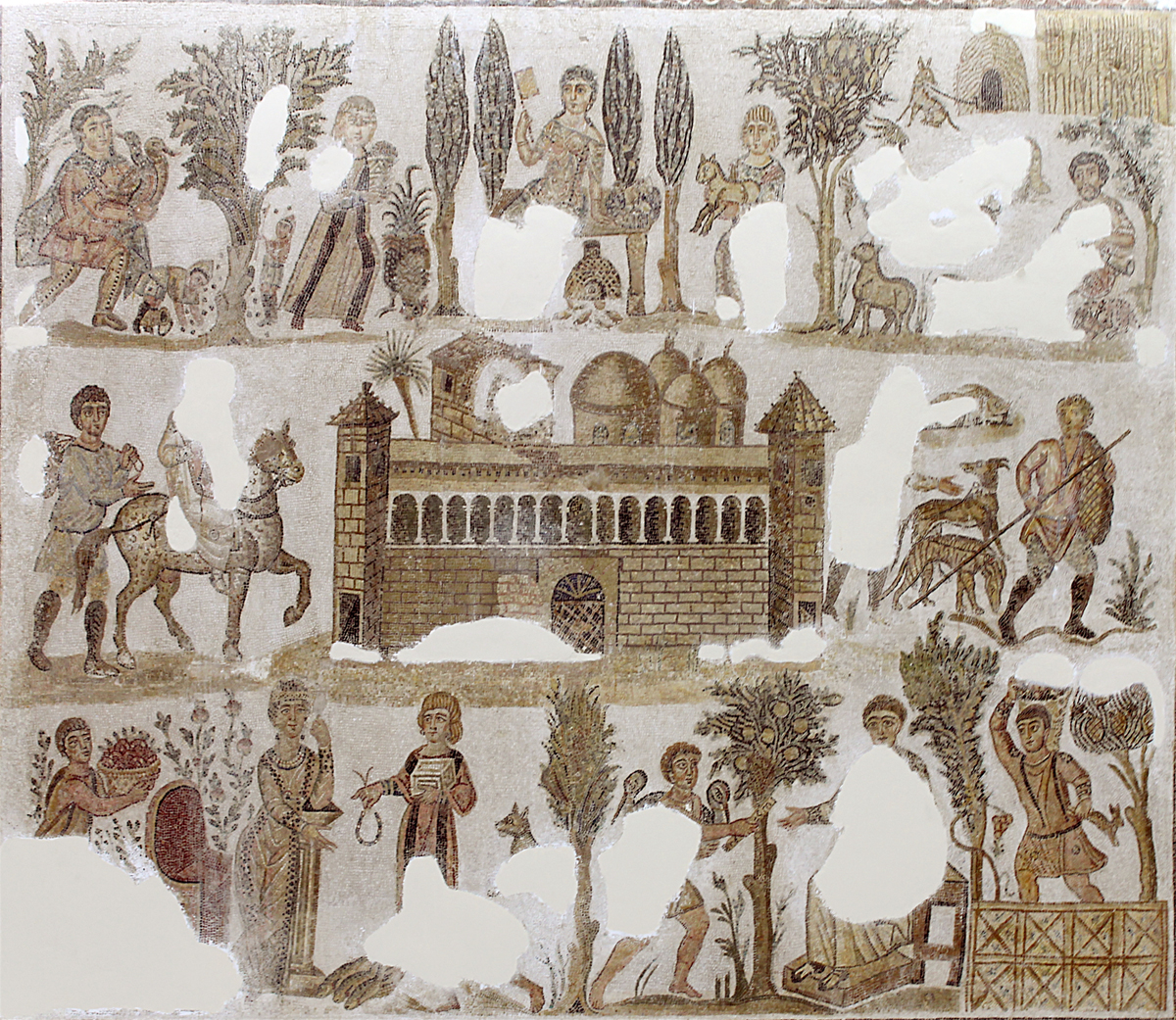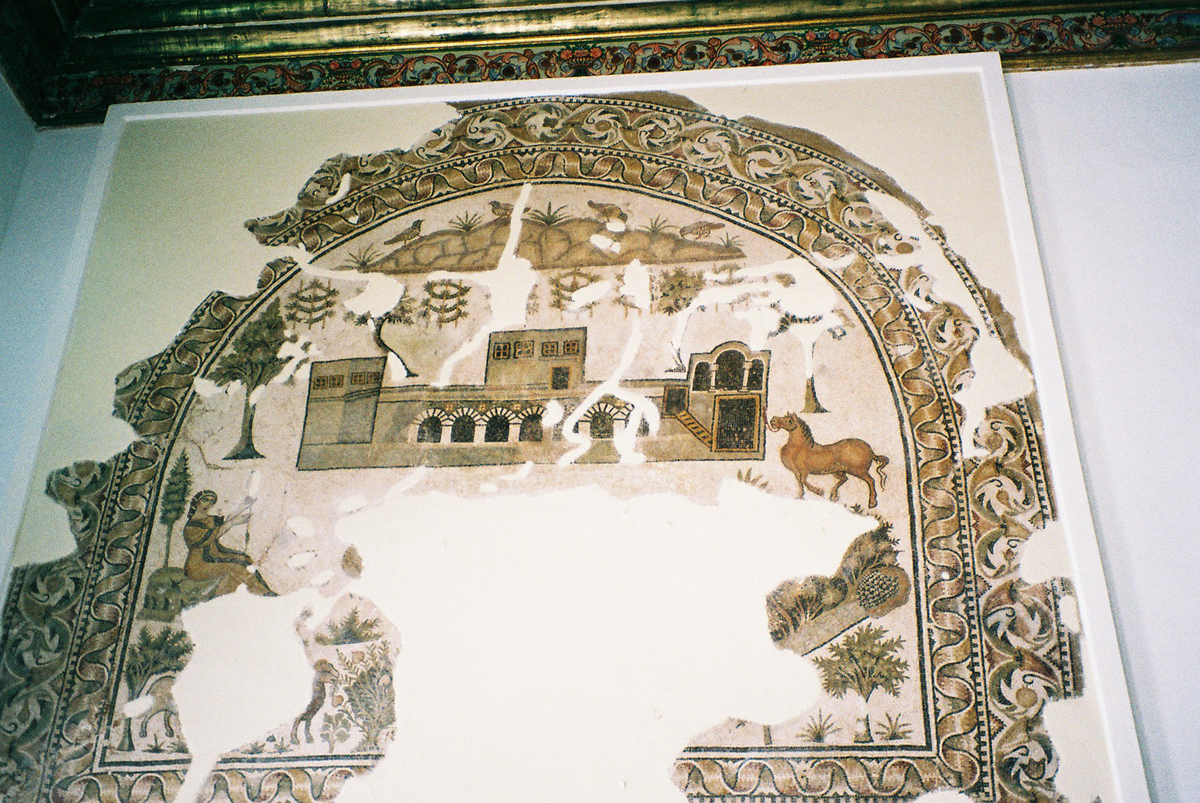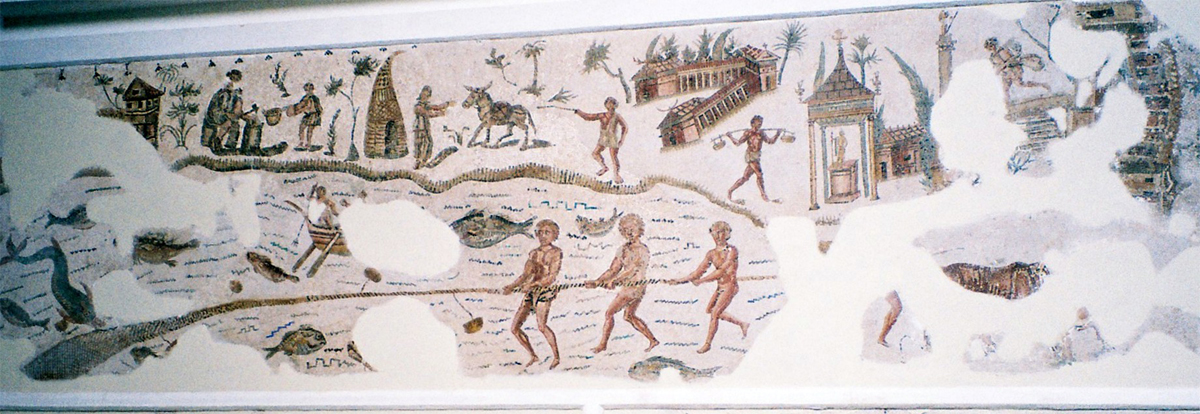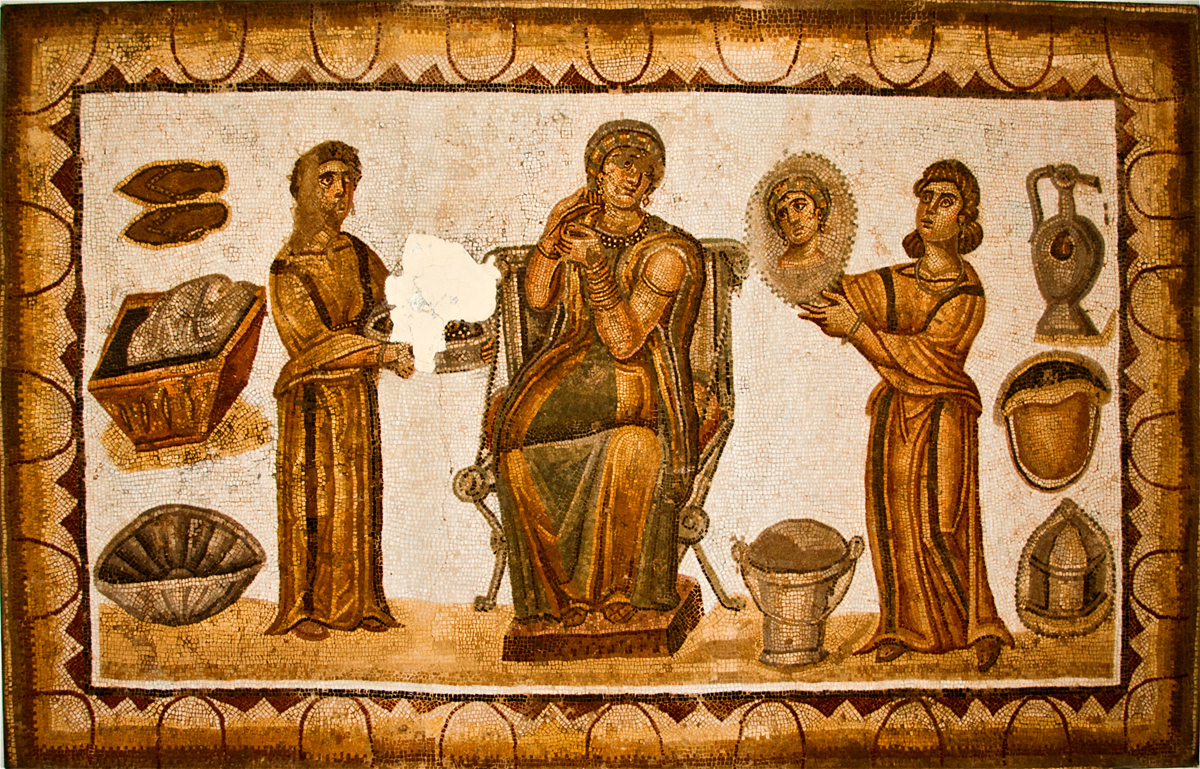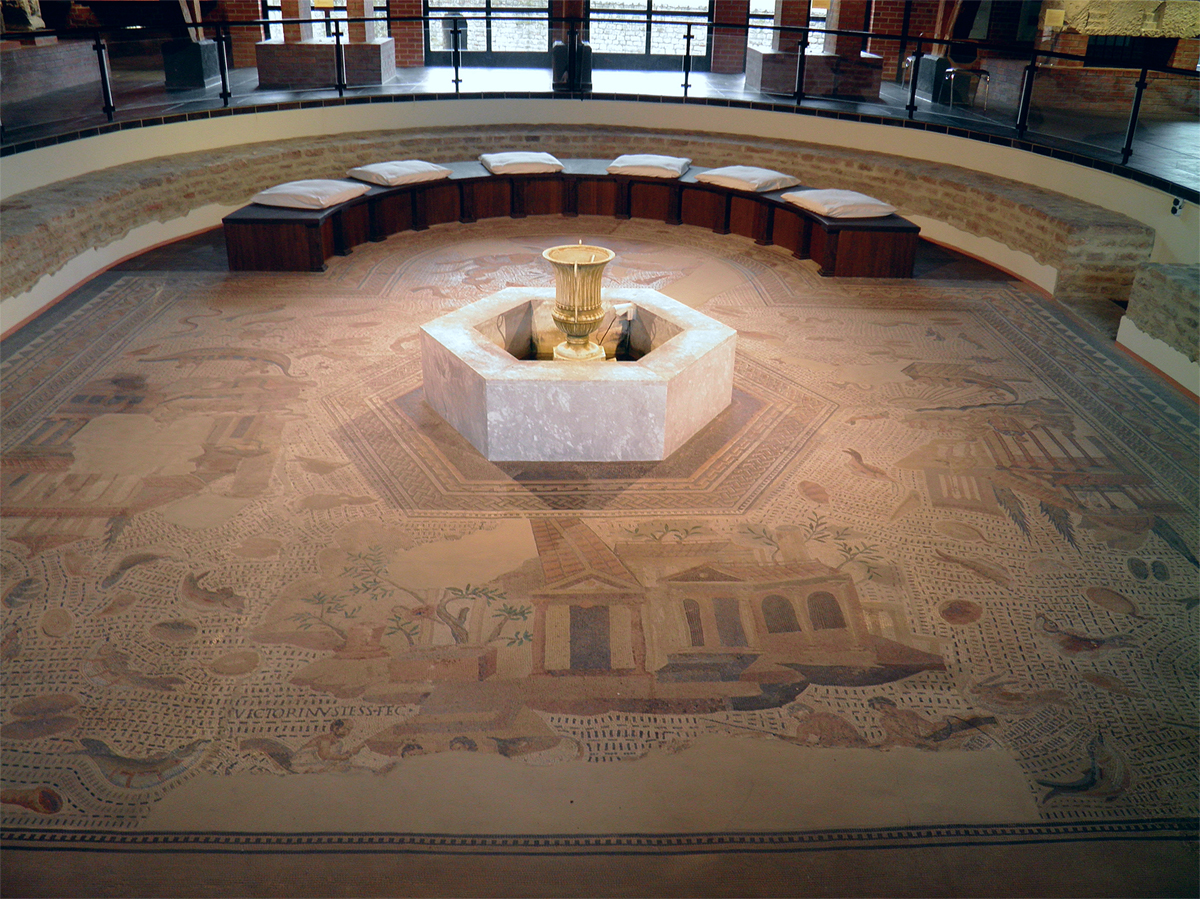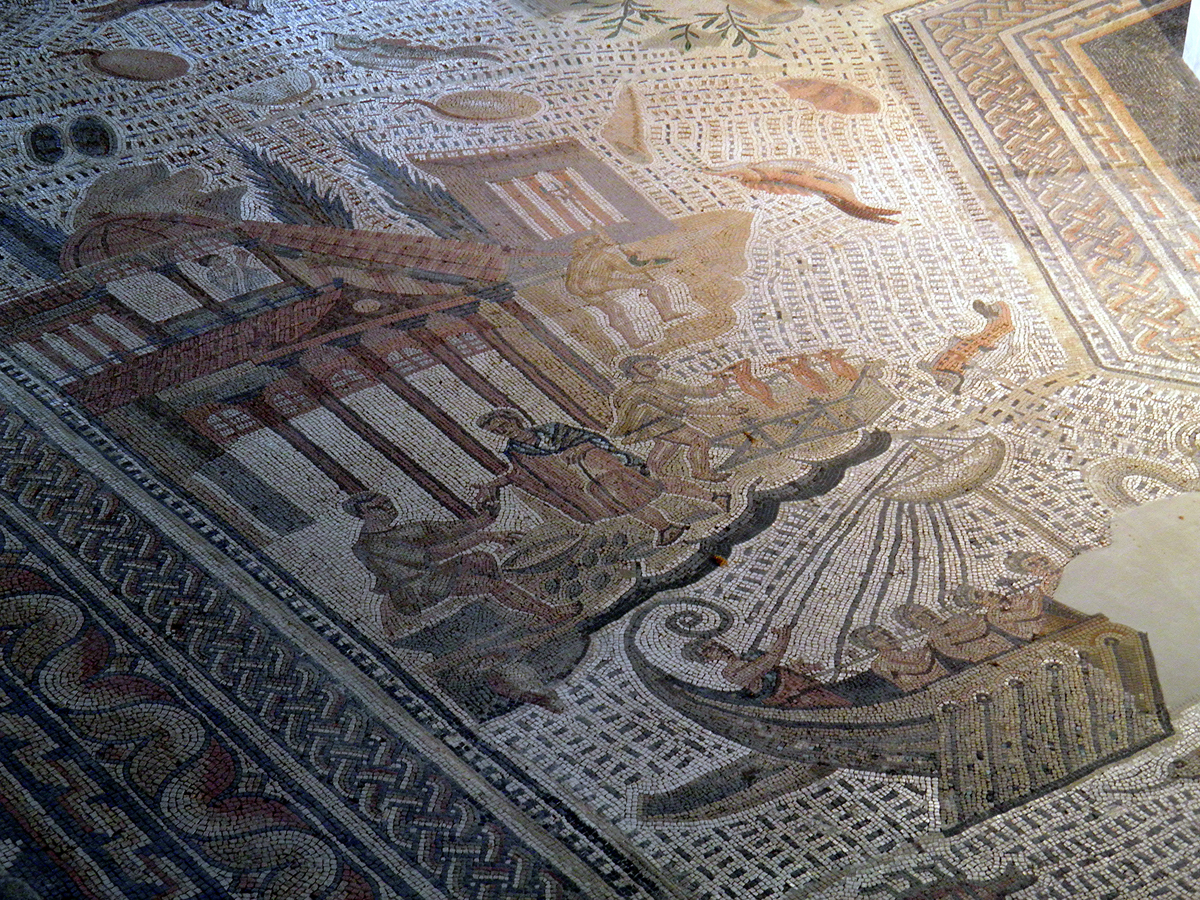Introduction
In recent years, there has been growing interest in the role that Roman visual culture played in creating and maintaining power structures through strategies of representation on various media (Clarke 2003; Trimble 2011; 2016), including mosaics. This is part of an overall trend toward studies of what material culture actually did in the social and political arena (Bennett 2010; Hodder 2012; Smith 2015, Bauer and Kosiba 2016; Van Oyen and Pitts 2017; Van Oyen 2020). Studies of elite and non-elite communication strategies have produced great insights into Roman social history. Agricultural mosaic scenes share a number of features that had an important impact on Roman social life. They certainly carry individual instances of symbolism, but they also share a set of features that created a whole ‘-scape’ which reinforced social relations over centuries. This was not necessarily a conscious process spread by word of mouth or shared as a specific piece of knowledge but was a strategy that lay deep within Roman culture. A small but important set of mosaics produced mainly in the western Mediterranean and northern provinces of the second to fifth centuries AD depict scenes of agricultural labor, food extraction and production, and distribution of agricultural produce. A specific mechanism operated within these mosaics; they had key features that helped to hide the agency of real workers. In doing so, they were claiming power over the time and energy of others.
Using Ingold’s concept of ‘taskscape’ (Ingold 1993), it is possible to locate these underlying features present in mosaics that gave them efficacy in Roman social politics by invoking the naturalization of ownership of one group over another: communities and groups at work, a sense of joy and comfort, anonymity of laborers, snapshots of processes within a narrative of idealized ‘deep temporality’, busy laborers, and generalization of the land and environment. The scenes showed the world only as one group saw it and created a world where only the form of taskscape was possible. This went beyond mere symbolic representation of powerful figures or landscapes as controlled by human agency. No landscape is ever fixed or neutral, but Roman elites used a series of mechanisms in art to show only one world of labor relations. It is now uncontroversial to say that elites used art to control non-elites, but what remains important is to expand the range of possible mechanisms used in Roman art.
Taskscape theory provides a complementary way of thinking about the politics of Roman art. A taskscape is an array of tasks and social relations that are revealed or hidden in a work of art. Taskscape theory encourages us to focus on labor as a unique category of study rather than as an addendum to land, places, objects, and individuals. Like other approaches, it provides a method to examine how elites wished to depict their role in producing the Roman world. What taskscape theory uniquely offers is a way to look at work and labor relations that are either implied or hidden from view. Taskscape theory specifically focuses on the things left out or implied by a simple image of labor. This is not symbolism, it is not what the image represents, but what the image evokes in the mind of the viewer. Thinking about taskscape provides an additional tool to explain mosaic imagery across the provinces and across the generations.
Ingold’s Taskscapes and Landscapes
In very general terms, the goal of landscape archaeology has been to study the history of human involvement in landscapes, that is, the way that people construct and develop arrays of places and their interrelations. For art history and archaeology today, landscapes are rarely just inert meaningless backdrops for human affairs; rather they are sets of places of meaning and interaction with social life. The origins of this large and complex intellectual tradition lie with geographers of the 1960s, who began to turn landscape studies toward poststructuralism and cultural relativism. The way that people construct and use landscapes, the ways that they draw meaning from them and ascribe meaning to them, and the way that they represent those landscapes and relationships in art began to be seen as highly culturally specific, malleable, and a source of social and political power (Lefebvre 1974; Relph 1976; Tuan 1977; Cosgrove 1984; Daniels and Cosgrove 1988).
This was picked up in archaeology most notably in the 1980s and 90s generally as a rejection of the Western Gaze (see work such as Evans 1985; Bender 2001; 2002), and a method for investigation of prehistoric and non-Western phenomenology and meaning (for example, Bender 1992; Tilley 1994; Bradley 1998; Edmonds 1999; essays in Ucko and Layton 1999; for more, see Thomas 2012). It has continued to evolve since then, centering on issues such as contested political landscapes (Bender and Winer 2001; Smith 2003; Kosiba and Bauer 2013) and more active approaches to decolonization and counter-mapping (Thomas and Ross 2013; Sunseri 2015). Art historians likewise recognized that the traditional Western approaches to landscape that were seen in art were not universal. Landscape art, therefore, was not neutral either. How to represent a landscape was a matter of choice, not a given (Green 1995: 31). Who chose what to represent? Who benefited from the messages communicated by that art? This was explained in terms of power and politics. As Nicholas Green states: ‘You do not have to be a doctrinaire Marxist to concur with the view that this [the non-neutrality of landscape art]… has something to do with the ownership of property’ (Green 1995: 31). Though not always landscape focused, nevertheless, meaning and power in Roman art likewise became important topics of study for Classicists, leading to a continual emphasis on the non-neutrality of Roman art and the messages it carried (Clarke 2003; Spencer 2010; Trimble 2011). This has led to a range of studies in the context of labor that have focused on the representation of work and the self-representation of workers (Petersen 2011; Holleran 2016; Trimble 2016; Ferris 2021).
A landscape is thus understood to be a set of relations, however defined, rather than an absolute space. Alongside depictions of landscapes in ancient art, the core objects of study for field archaeologists have been houses, tombs, monuments, forts, harbors, and cities. This has necessitated looking at arrays of places to understand social relations. But there are other arrays of relations within landscapes that can be studied, arrays of tasks, for example, which have been a topic of extensive research in archaeological theory. This is where the ‘scape’ as taskscape becomes important.
The idea of taskscape has been utilized on occasion over the last 30 years (particularly in Rajala and Mills 2017). In a seminal 1993 article, The Temporality of the Landscape, Timothy Ingold set out the conception of taskscape as reflected in the landscape as a method for better conceptualizing social life. His goal was to create a juxtaposition between landscape and taskscape for practical purposes. His larger aim was to:
‘understand the inhabited world of the organism-person in a way that would override or even dissolve the barrier between nature and society. The solution I eventually found was that they could indeed be merged, but only by restoring taskscape to the textures of the land, and landscape to the current of time’ (Ingold 2017: 20).
He wished to show that rooted within any image of a landscape was an implication of deep temporality, a history of tasks and human labor. Here, and in his later work (Ingold 2000; 2011; 2012; 2015; 2017), he used this idea to strengthen and invigorate the term landscape. In essence, adding ‘taskscape’ saves ‘landscape’ from becoming too devoid of real social life.
‘Taskscape can be a handy moniker for a descriptive account of the spatiotemporal layout of activity at a site, which is exactly how I had used it myself when… I had first introduced the term. I suspect it is how it is still being used today in archaeology and (to a much lesser extent) in anthropology. We should never forget, however, that human beings, like organisms of all sorts, belong to the land: they are formed of its flesh and participate in its processes. Taskscape is no more and no less than landscape brought back to life’ (Ingold 2017: 26).
Ingold (1993) used Pieter Bruegel’s 1565 work The Harvesters (and, in 2017, The Battle Between Carnival and Lent) as an example of how deep temporality was visible in an early modern landscape painting (Figure 1). It was not just a landscape, but a taskscape too, and the two were inseparable. The activity of people is implied by their current state. In other words, seeing the farmer resting suggests he was just working. Seeing people eating suggests someone earlier that day had made the food and packed it up. The well-manicured fields suggest the long-term maintenance of the fields by the community. The church in the background implies a deep history of construction and ritual tasks, and so on. Ingold argues that scape does not etymologically mean a vista or view, but rather a shaping or working. He states:
‘In this medieval sense, landscape already couples the land with the tasks of shaping: landscape is taskscape because to shape the land is to work it. In his painting of The Harvesters, executed on the cusp of the transition from medieval to modern sensibilities, Bruegel has given us a superb evocation of what it means for land to be thus entasked’ (Ingold 2017: 24).
Pieter Bruegel, The Harvesters, 1565, New York, Metropolitan Museum of Art (19.164). (Photo: Licensed under CC0 1.0 Universal Public Domain Dedication).
In addition to its definition as an array of tasks, taskscape also entail an array of social relations (labor relations or relations of production). A landscape painting (or a landscape mosaic) is thus a representation of various relations of place and work. Roman visual culture made use of this interconnectedness to present a very particular normative vision of labor relations. To understand the strategy employed unconsciously in Roman elite culture, however, it is helpful to momentarily retain a division between the landscape as an array of places and the taskscape as an array of tasks. What taskscape can display at its core – process, tasks, and work – remains a useful contrast to the landscape itself, which has a scholarly tradition much more extensive than taskscape theory.
It is worth noting that Ingold’s archetype landscape-taskscape is a rural scene in a pre-industrial hierarchical agrarian economy. There is no reason to presume they would map easily onto the Roman rural world, but, in the broadest sense, they do. The standard agricultural taskscape features help identify a characteristic naturalization of hierarchical agricultural labor relations where some benefit disproportionately from the work of others. These features show:
Communities and groups at work
A sense of joy and comfort and images of happy workers
Anonymity of workers
Snapshots of processes creating a sense of incompleteness. They are ongoing but it is not clear if they are once-off or repeated or perennial.
Snapshots of processes within a narrative of idealized ‘deep temporality’ (a sense that the image is showing the result of processes occurring over considerable time)
Workers who are ‘chronically busy, perpetually in motion’ (Ingold 2017: 24) – people who are themselves tools, without rest and real lives and agency of their own.
Generalization of the land and environment (even when a specific location is shown)
These features entail a whole set of tasks and activities which are hidden from view and open to the imagination of the viewer. A taskscape may not even look like a landscape; it might be a domestic scene or a vignette of daily life. While the actual images vary enormously, these features appear in agricultural mosaics across the Mediterranean across multiple centuries and regions as well as in various different kinds of homes and cultural contexts.
When a viewer sees the work of art, they fill in a narrative from their own experience and intuition (Ingold 1993). Taskscape thus forces us to focus on what is implied and presumed. At the same time, they also make use of what is hidden entirely. What is missing is as important as what is visible. Perhaps a viewer sees a single tree and imagines an aged forest. Perhaps they see a ship and imagine a stevedore carrying an amphora or a sailor manning the sails. An image of a city might suggest generations of work, maintenance, and politics. It goes in reverse too; perhaps the viewer sees a hammer and imagines a blacksmith’s workshop. They will also imagine sets of social (labor) relations: master and slave, employer and employee, patron and client, parent and child. Even today, archaeological site plans and landscape maps do something similar. The reader of an archaeological publication will see a square and may imagine a house, a landscape of rooms and objects imbued with meanings by people, an array of tasks including years of processes of building, cleaning, cooking, and socialization, and a set of social relations between relatives, friends, neighbors, and even the state. The archaeologist’s prose account may help structure and define the landscape and the taskscape to temper the pre-existing ideas of work and activity that the reader brings to the context. Argument meets imagination whenever images evoke and enact complex sets of expectations, memories, and normative values.
What this basic understanding of taskscape does is create space to investigate how these images, processes, relations, and narratives interacted with one another in the Roman world. It goes without saying that Roman elites used art to shape social and political life in their favor. Images presented normative reality. The patron sets out an array of tasks and social relations that suits them. As mosaics last through generations, the images present social norms from the past for use in the present. In most cases, the person who was not the primary agent or worker in the image was the person who benefited the most from the activity in the scene. Even as generations passed, the images would reinforce social solidarity and confidence between elites and communicate their power to any non-elite who saw them.
It is best to work from the premise that such images influenced viewers’ worldviews and became a part of the general ideology and behavior even of those who did not see the images directly. The images had real effects, even if it was not a simple process of didactic messaging, but a process of hiding meanings out of sight. In Roman mosaics, for example, workers rarely have names while abstract entities such as the Seasons and the gods do. The instruments of control over slaves are rarely seen. We generally see one or two people, not the reality of dozens or hundreds of workers answering to a dominus. Nor do we see the hierarchical social networks at play. Separating the taskscape from the landscape as a heuristic tool allows these features and discrepancies to become apparent to us.
Types of Mosaics and Contexts of Interpretation
The genre of mosaic in the Roman world was widespread and varied in form and content (Dunbabin 1999) and their means of communication are complex and varied (Malek 2017). The most numerous forms of mosaics are figurative (mythological), botanic, and geometric. A small but important body depict scenes of agricultural, domestic, or commercial labor. Agricultural labor images are perhaps the most common, but they also depict other types of labor. This includes what has been traditionally recognized as male labor (free or slave) and also forms of unrecognized labor also, such as unpaid female labor (Bhattacharya 2017: 1–3). They appear in great frequency from the early Imperial period onward. Generally, this form of art does not last much past the fifth century in the West and the sixth century in the East, a considerable longevity, but one that failed to carry weight as the ideological strategies of the Roman aristocracy shifted to militarism (for the militarization of the late Roman aristocracy see Esmonde-Cleary 2013). The most common include agricultural work, hunting, fishing, distribution and commerce, domestic service, and performing music and dance. The primary theoretical approach to Roman landscape art in recent decades is analysis of specific discrete features or sets of features as symbols that transmit or convey a specific social or political meaning and message about the maker, owner, or persons depicted (for example, Rose 2008; Parodo 2019).
Unsurprisingly, most agricultural mosaics have been found in villas, but are also found in urban houses and occasionally public spaces. Within the category of villas there was great variation. The villas themselves vary greatly in form, function, and scale. In terms of occupancy, they were not uniformly and consistently inhabited by a patron and his household. There was a great variety in how villas were used. There is extensive research in this area that has developed significantly in the last decade (for recent synthesis see Marzano and Métraux 2018). One of the most enduring questions in the study of Roman domestic mosaics has been to what extent images of estates depict real people and places, or merely generic and ideal forms of them (Wilson 2018: 274–76). Wilson argues for the latter, but it remains an open debate, varying from villa to villa and province to province. There are few answers as to why either option would have been more desirable.
One similarity, however, is visual culture, most obviously mosaics’ role in claiming ownership over the taskscape and landscape of others’ work. This only makes the uniformity of ambiguity in mosaics more interesting. Despite vastly different contexts on the ground, within their genres, these mosaic patterns hold remarkable artistic consistency in showing generic places, contented workers, and snapshots of processes. There were also vague places which looked somewhat like the local estate, villa, or city, but were not a perfect representation. The level of specificity of any image was a factor of the skills of mosaic layers, their use of standard ‘cookie-cutter’ images, and the physical limits of the mosaic medium. Elites present themselves as champions of stability, continuity, order, prosperity, and peace. Standard art forms that show their possession of order and prosperity, made possible by carefully hiding reality, helps to promote their class solidarity for generations. These mosaics never show significant change or conflict.
It is impossible to say for certain who their audience was, but it is reasonable to suppose a core viewership that was occasionally expanded. In villas we can suppose the frequent presence of free members of the elite family, friends, and peers in the local elite, as well as visitors from further afield. Non-elites also saw these mosaics. Domestic workers, both enslaved and free, would have been present in the villas in the course of their work. Agricultural workers themselves, enslaved or free, were probably a rare sight, but may have been present on occasion for festivals or occasional business.
Roman mosaics lasted for generations. If ownership of a villa changed, the owners themselves may have no familial ancestral connection to the person who commissioned the mosaic nor the workers who laid it. In public or semi-private spaces, there would be little memory for the average viewer of a mosaic’s production context. In many ways, the physical durability and long life-history of mosaics strengthened the value of the image itself in comparison to memory of its production context. Thus, while the intentions of a specific patron or the artisans who made a mosaic are worth consideration in analyzing the political strategies of the design, there is a much larger context of viewers to consider also. In other words, we should avoid the risk of, in Dunbabin’s terms, ‘exaggerated exegesis’ of mosaics and their patrons and owners (1999: 323). In the end a great deal depends on how we imagine the Roman viewer, something which calls into question our own assumptions and biases. But mosaics, due to the longevity of the genre and visual language, must have formed a part of elite praxis and cultural hegemony — the overall strategy was to send a similar message to all of society, and thus it at least attempted to treat each viewer uniformly, even if that did not always happen. The mosaics thus had an intended viewer of their own construction, anyone who needed to be reminded that he who controlled labor and land without doing the work himself ought to be dominant in a hierarchical society and tributary economy. This is a more useful starting point than trying to identify an imagined individual or set of individuals and interpret the genre from an imagined perspective.
The exact relationship between these forms and analysis of agricultural treatises and technical writing, poetic, or historical texts that depict domestic tasks, instrumenta domestica, statues, epigraphy, lamps, and coins, remain to be fully studied. Squire (2009) has argued against simple a priori separations between ancient texts and images, to restore the importance of the image in antiquity. For heuristic and practical purposes, this study limits itself to mosaics, but the pattern may hold true elsewhere. For similar reasons the images in this analysis are examined more for the contents of the image than specifically their place in the villa, although the associated contexts, spaces, artifacts, and specific cultural moments are essential to understanding the mosaics in full.
The following discussion will focus on the taskscape features that meet the criteria laid out above. Of course, these leave out the full range of cosmological and religious symbolism in these images (see, for instance, Cosh 2001). Those meanings complement the taskscape features, and may have been bound up closely with the viewer’s understanding of the art. However, because they operate on a different level of symbolism, it is best to treat them as analytically separate to the taskscape features discussed here.
The Shared Taskscapes of Agricultural Mosaics
Using case examples from various regions of the Roman world and from various centuries (The Calendrier rustique of St. Romain-en-Gal, the Mosaic of the Months (El Djem) calendar, The Estate of Dominus Julius from Carthage, the Tabarka villa scenes, the Matron Mosaic from Sidi Ghrib, the Cherchell Mosaic, The Piazza Armerina Great Hunt, and the Bad Kreuznach Oceanus Mosaic), the following discussion presents possible interpretations of how this strategy was maintained in visual form.
The hallmark features of taskscapes appear commonly in seasonal agricultural mosaics, notably in a panel mosaic known as Le Calendrier rustique. This mosaic was found in a rural villa near Saint-Romain-en-Gal, along the Rhône beside Vienne and is now housed in the Museum of St Germain-en-Laye. The mosaic dates to the early third century AD when it was built into the floor of a reception room. In this example we see a mixture of seasonal allegory and an estate’s (real or idealized) annual production tasks. Winter, shivering in a blue cloak, rides a boar. Spring, wearing a foliage crown, rides a bull. Summer, carrying a sickle and a wreath of wheat, rides a lion. Autumn, with a basket of grapes, sits on a panther or tiger. The remaining panels show productive tasks and estate activities for the year: picking grapes, treading grapes (Figure 2), pruning trees, picking olives, pressing oil, ploughing, transporting manure, sowing seeds, baking bread, and sacrificing to the lares, for example. Each panel is arranged to be most visible to a viewer standing on the edge nearest it. The surrounding landscape is vague and empty — occasionally a tree places the actions in a generic context. The real tasks are mixed in with a series of allegorical portraits of the Seasons. Similar images of work appear in the calendar known as the third-century Mosaic of the Months from El Djem now housed in the Sousse Museum. July (Figure 3), for instance, shows a man carrying a load on his back, perhaps a bundle of sticks for picking or eating fruit (Salzman 1991: 113). In September (Figure 4), two men are busy crushing grapes to make wine. In addition to examples of work, other months show people carrying out religious rites, statues of deities, and festivals. This was not accidental, though it may have not been explicitly discussed. It can be an effective tool of the distancing process to mix the allegorical and the real. The workers appear to work happily and anonymously. The calendar is not didactic (unlike agronomic texts). It does not attempt to instruct about correct actions or procedures. Instead, it naturalizes the surrounding social power structures.
Portion of the Mosaic of the Months, El Djem (Sousse Museum), July. (Photo: Ad Meskens, licensed under Creative Commons Attribution-Share Alike 3.0 Unported License).
Portion of the Mosaic of the Months, El Djem (Sousse Museum), September. (Photo: Ad Meskens, licensed under Creative Commons Attribution-Share Alike 3.0 Unported License).
Each task is a snapshot located within a vague landscape. One thing that is hard to capture in the calendar model is ancillary activity. The harvest of one month involves a whole array of unique, regular, or repeated activities, but only one snapshot of it can be shown at a time. Pieces are chosen very carefully to stand in for the whole array of tasks that go in to producing the wealth of an estate. Many tasks, notably the more unpleasant tasks are missing, for instance, the punishments to be inflicted on the lazy, the buying and selling of slaves, and the hiring and abandonment of wage laborers, the intermediary of the estate-manager, and the non-productive activities of the estate owner. It is the very act of hiding these things that naturalizes not the actual work depicted, but that which is not. The agronomists also attempt to hide this by appeal to ‘moderation’ in the subjugation and exploitation of enslaved people (Cato, De agricultura 5; Varro, De re rustica I.17–18; Columella, De re rustica. I.6–9; Palladius, Opus agriculturae I.6.18). However, the texts come with a host of their own philological and literary complexities that make them difficult to directly compare to mosaics, though taskscapes in texts represent a ripe area for further exploration.
Naturally it would not be possible to represent an entire taskscape using moving pictures on a mosaic, but this does not lessen the visual impact of what was created in antiquity. Many viewers would have knowledge or memory of the wider taskscape and a single moment could be enough to recall a larger whole. People with less experience of the exploitative and precarious nature of slavery and estate life would not have those images come to mind at seeing these mosaics, but those who had would be reminded quickly that the elite oversaw it and that the elite looked at it with admiration.
Agricultural calendrical mosaics are also common in churches and other ecclesiastical venues in Late Antiquity. Parodo (2019) has presented a detailed demonstration, including an enormous range of examples, of how calendars were used to confer authority on Roman elites using iconographic and symbolic messages. A range of imperial motifs related to aeternitas resonate throughout the calendrical mosaics. This association with an eternal and prosperous order was a core vehicle for elite ideology (Parodo 2019: 483–91). However, elite ideology was not only reinforced through positive associations with distinct symbols. In the full range of agricultural mosaics, it is not just iconography of the Seasons, for example, but the implicit claims of ownership and the denial of the reality of production, as well as the other features of taskscape art that convey the message of elite dominance. The images are not just about the virtues of the aristocracy (Parodo 2019: 488–91), but about the denial of depth and agency to workers who are shown within them.
In addition to calendar mosaics are more general agricultural mosaics. The agricultural mosaic from a house in Cherchell (Caesarea Mauretaniae) in Algeria dating to the second to third century AD (Figure 5), was found during excavations in the 1920s. It is now housed in the National Public Museum of Cherchell. It measured roughly 5.25 meters by 4 meters and was found in a semi-rural villa. This mosaic has served as an important source of information for agricultural tool use — it was used by White in his seminal study on Roman agricultural tools (White 1967). Unfortunately, the exact furnishing of the room is not known, nor precisely its function (which may not have been fixed).
Cherchell Mosaic, men collecting grapes. (Photo: Yves Jalabert, licensed under Creative Commons Attribution-Share Alike 2.0 Generic License).
The figures in this mosaic are more detailed and it has a more energetic style than typical agricultural mosaics. Color contrasts are more vivid, the figures are more detailed, and there is a greater sense of movement and tension, in contrast to the rather rigid and simple figures of Dominus Julius, although it shows a reduced number of people, places, and tasks. This movement extends into the landscape features — trees, once again. The vines and tree branches warp their way around the people and animals to dominate the scene. The workers are anonymous again but appear to be more strained and burdened than in other mosaics. Fundamentally though, it is little different. The landscape is simple, with little more than some soil and branches. The occasional extra feature, a trellis for instance, adds some variety. Ploughing is one of the two dominant activities in the mosaic, oxen feature in two of the panels, and viticulture in another. Again, the workers are nameless and generic. If they were real people at one time, they would be forgotten for most of the life of the mosaic in later generations. If they were simply schematic, then the work was anonymized also. While different groups of artisans shaped the medium in their own way, the overall visual culture held these principles in place. Not all images of agriculture follow the general rules of the taskscape pattern exactly, but none show the more sinister, specific, or full range of tasks that would call into question the order of things with the dominus at the center. It is obvious enough that elites would promote themselves. What is important is that they do so by shaping viewers’ perceptions of tasks and the taskscape directly. They do this by making their image of the taskscape appear obvious and natural.
Aside from taskscape and labor mosaics, mosaics also bear many images of vines and fields with Dionysus, the Seasons, Pan, or other religious symbols of nature or agriculture (Dunbabin 1971). What about images of Dionysus or the Seasons as religious iconography? There are other forms of agricultural images connected to Dionysus, and the Seasons are present in many guises, which have a different strategy for achieving similar results. Establishing the elite’s ownership over religious iconography (and thus their connection to the order of the cosmos) was another strategy of justifying their position. This has been well documented. Eckersley (1995), for instance, has shown convincingly that Dionysus is frequently included in agricultural mosaics, usually ones which depict the vine, with or without images of human work, as a way of justifying elite control over the fruits of the earth. This has the same goal, but a different strategy for achieving it. Elites could claim a special connection to the gods and the world by depicting religious iconography. However, even Dionysus did not directly control the work force, and a more subtle but no less effective strategy was needed.
One of the most well-known agricultural mosaics in North Africa comes from the so-called estate of Dominus Julius at Carthage, which shows a ‘conflation of seasonal ceremonies’ (Rose 2008: 44), supposedly carried out on the estate. This mosaic adds complexity to the standard features of the taskscape seen above. It shows the relationship between dominus and domina and their relations with their slaves. This part of North Africa was a major producer and supplier of agricultural products and took advantage of the trade supplies going to Rome. The fourth or early fifth century AD mosaic consists of three registers with images of agricultural life (Figure 6). Four figures (two male figures, one sitting on the bottom-right and one riding a horse, as well as two female figures, one sitting and one standing) on account of their expensive dress and stances have been interpreted as representations of a dominus and domina of the estate (Parrish 1979). This is even clearer in the case of the dominus, where in the bottom-right a slave brings him a letter inscribed ‘Iu(lio) Dom(ino)’ (Rose 2008: 44).
The Estate of Dominus Julius, Bardo Museum. (Photo: Boyd Dwyer, licensed under Creative Commons Attribution-Share Alike 2.0 Generic License).
The villa itself sits in the center of the mosaic, built heavy and strong. As Wilson has noted, based on comparison to the archaeological vestiges of the building, they do not usually depict the villa literally (2018: 276). We can only speculate as to what people thought of these figures in later periods of the villa’s life. The landscape beyond the villa itself, the array of places, consists of a variety of trees including poplars and olive trees. In the top right, some outer houses may represent agricultural production centers or huts for workers. It is a vibrant scene of activity, a rich tapestry of tasks, and a diverse set of characters performing them (often with animals in tow). One male figure carries a spear and is joined by two dogs for the hunt. People collect fruits fallen from the trees. Not a single individual is named, though their social positions are no doubt meant to be understood implicitly. The landscape is again vague and empty — it has to be filled in by the viewer’s own knowledge.
Taskscape features can be seen again on the dining hall mosaics from the early fifth-century AD rural villa at Tabarka. Each of the three apses of the dining hall contained a mosaic that showed rural buildings set in an arboreal landscape. In the bottom-left corner of one of the mosaics (Figure 7), a woman in fine dress sits spinning wool to make clothing, a repetitive task which she appears happy to carry out. The middle of the mosaic is damaged, but in the rest of what remains, a horse, a camel, perhaps a donkey, and some birds eat in serenity. Except for the birds, the animals are not wild, but probably domesticated beasts of burden; the horse, for instance, is wearing a bridle and is tied to the building. The community is in fact hidden from view and is implied by the presence of the large villa sitting at the center top of the mosaic. The other two mosaics in the room bear the same structure, however, with different sets of buildings. The lack any other human figures makes it harder to assign a clear taskscape label, but the presence of beasts of burden, and a woman carrying out her domestic roles marks a clear definition of Roman rural order with villas at the center.
Tabarka, side apse of suburban villa, building with landscape and woman spinning. (Photo: Verity Cridland, licensed under Creative Commons Attribution- 2.0 Generic License).
A more energetic set of examples, like the busy landscape of the Dominus Junius mosaic, come from a villa at El Alia (ancient Uzalis) on the north coast of Tunisia (Picard 1990: 3–14). The original excavations did not record the precise excavation contexts of these mosaics, which date somewhere from the first to the third centuries AD, but it is likely they came from a large coastal villa in northern Tunisia (Picard 1990: 5). On the largest of three mosaics (Figure 8), again we see a community at work around a lake or bay, seemingly contentedly. In the front, three men are net-fishing while other men fish from a boat. Toward the middle background, a donkey is carrying a load and a man carrying a yoked load over his shoulders. In the left of the image, a craftsman or blacksmith and an assistant are at work. In a damaged area in the bottom right there appears to be a figure pulling an ox. Like at Carthage and Tabarka, large villa buildings dominate the scene. In contrast to the large ornate villa, there is a small makeshift hut where workers may have rested or lived. In the other mosaics from the same complex, there are scenes of slaves preparing wine for their master and workers handling a team of oxen. The scenes are generalized and anonymized. The people use tools but are themselves the tools that produce and reproduce the villas and the order of the landscape in these scenes.
Mosaic from El Alia, with taskscape. (Photo: Verity Cridland, licensed under Creative Commons Attribution- 2.0 Generic License).
There is little known about the owners of these mosaics beyond what can be inferred from the mosaics. Intersecting power structures also used the taskscape package to minimize others’ work. In the estate mosaics, two classes are present: the two wealth and powerful landowners in contrast to the enslaved workers. In the case of the Dominus Junius scene, Rose (2008: 44) has noted the clear gender imbalances present in the scene. The dominus is the power center. He rides a horse, itself a symbol of power, but also one that suggests that he is in control of travel and communication with the outside world. This is confirmed by his receipt of the eponymous letter in addition to fruits of the estate (grapes and a rabbit). Meanwhile, the domina, who is clearly in control of slaves, sits with her dress slipping off in apparent emulation of Venus. She is a sexualized symbol of fertility and passively receives other fruits of the estate from its workers (Rose 2008: 44). The Matron Mosaic from the bath house of a large elite villa at Sidi Ghrib (Figure 9) shows the similarly powerful position of another domina, but a position that remains imbued with gendered structures. She sits at the center in fine clothing, and is served by two slaves. One of them holds a mirror up to her. The slaves are well-dressed even while at work (Rose 2008: 44). Around the edge of the mosaic, which are expressions of the refined life of the domina. At the same time, they are the slaves’ objects of work. As such, an iconographic interpretation would suggest that symbols evoke the virtues of the elite and through position and visual language remind the viewer of expected social hierarchies. At the same time, the taskscape that is shown here is itself one of daily or annual cyclical repetition, the anonymity of the workers, and bear the expected general sense of order and comfort. These images show both gender and class relations in as positive a light as possible, and clearly demonstrate the complex sets of ownership over labor that they claim as normative in addition to associations such as the domina as Venus.
The Matron Mosaic at Sidi Ghrib, Musée National de Carthage. (Photo: Fabien Dany – www.fabiendany.com/www.datka.kg, licensed under Creative Commons CC-BY-SA-2.5).
The association of mosaic in general with persons such as Julius, however, should not cause us to lose sight of the fact that it was multi-generational. On the surface, this kind of mosaic parallels The Harvesters — it is possible to ‘fill in the gaps’ in the landscape and especially in the taskscape, however one wishes. The image symbolizes the dominus’s ownership over land and people but presents no space for negative realities. Just as in the calendar example, the taskscapes depicted are generalized, as is the landscape, and portrays an idea of naturalization of the power structures established by the villa.
Hunting and gathering exotic animals for games were other aspects of elite Roman culture — work that was done by slaves or hired workers. The fourth-century Great Hunt scene from the villa at Casale (Piazza Armerina) presents a far more detailed scene than the others, but one that contains elements of production (in the sense of collecting resources) and distribution. The vast complex of Piazza Armerina is representative of the grandeur and increasingly public face of late Roman rural villas. The Great Hunt scene lay in a hall beside the basilica and just off the central peristyle within the overall immense rural villa complex. Does this confirm the pattern observed above or break with it? Despite the expansion of the detail of the taskscape and even bolder claims of the power of resources, it retains the same basic taskscape strategies: showing anonymity, happy workers, generality, timelessness, and the positive aspects of estate labor. There are exotic animals — lions, antelope, tigers, and ostriches. All the figures are clothed in the new fashions of the later Empire; multi-colored tunics with artwork, round flat shields, leggings or stockings, and capes. As in the case of The Estate of Julius Dominus, the elite figures are often placed on horseback. The environment is simply represented by some generic trees and grass, with large gaps between them. The lines of water, fish, and two docked boats give a sense of a coastal landscape, one an imagined African coastline and the other a more familiar Sicilian shore. Even though the actual tasks here involve trade and distribution as much as production, they nevertheless show continued evidence of the same strategy.
As the mosaics at Piazza Armerina show, both images of production and distribution were part of the strategy. Maritime taskscapes also adopt these forms. The Oceanus mosaic (Figures 10 and 11), from a large inland peristyle villa rustica of the second and third centuries 40 km from Mainz (Mogontiacum), the provincial capital of the province of Germania Superior and home of the Classis Germanica, presents a clear example of a holistic image of harbor life. The mosaic itself measures roughly 8×8 m with a water fountain at the center and an apse at the top. Ulrike Ehmig (2005) has argued that the piece was a special commission based on the uniqueness of the specific images, although similar scenes in general are not rare. She also argues that the amphorae shown in the mosaic are from the eastern Mediterranean and this suggests that the owner traded with that region, and it is now known for certain. A partial inscription mentions the consuls of the year AD 234, but no further information. Almost hidden within the mosaic itself is a reference to the mosaicist: Victorinus tess(eccarius) fec(it) [Victorinus the mosaicist made this].
The Oceanus mosaic at Bad Kreuznach in context. (Photo: Carole Raddato, licensed under Creative Commons Attribution-Share Alike 2.0 Generic License).
The Oceanus mosaic at Bad Kreuznach, ship and port. (Photo: Carole Raddato, licensed under Creative Commons Attribution-Share Alike 2.0 Generic License).
The eponymous image of Oceanus lies in the apse section and around the fountain there is a series of maritime scenes. Fish and other marine creatures fill the ocean, two boats with mariners row back and forth. On shore, a man sits selling mussels to an eager buyer. Behind him, a worker sets up three amphorae, presumably for sale. The figures in charge (or perhaps it is the same figure repeated) wear red and blue, while the ordinary workers wear off-white tunics, marking a similar sense of hierarchy as in the previous mosaics. The ordinary workers are undifferentiated and generic. Work identity in commercial settings is thus hidden by timelessness and permanence. Again, we see a community at work. Tasks are allotted and carried out by everyone with apparent joy. The landscape teems with life for the harvesting. The scene contains three buildings, and while they may reference specific buildings, they could be anywhere. The commissioner of this mosaic and the mosaicist Victorinus have created a generalized taskscape that suggests the continued ownership of this landscape and this taskscape.
Conclusions
There was a common core set of features, which we can call taskscape features, of agricultural mosaic art that was shared across time and space. We see anonymous communities happily at work. We see snapshots of processes that appear incomplete, ongoing, occurring over considerable time; but it is not clear when or where. We see workers who are themselves tools, without rest and agency of their own. We see generalization of the land and environment even when a specific location is shown.
Scholars have identified many of the symbolic mechanisms Roman elites used for sending messages via mosaics, including symbols of time, nature, mythology, status, lineage, and power. Likewise, scholars have shown how depictions of landscapes always transmitted complex and perhaps contradictory political messages. The concept of taskscape, however, provides an alternative lens through which to view Roman art as a means of communication and control. The specific taskscape features, which are not symbols in and of themselves, helped to hide the fact that the wealthy lifestyles of the elite were provided for by the work of others. Mosaics were an essential part of elite power structures that lay deep within Roman culture and within hierarchical agricultural life.
Further work is needed to refine this and to assess the role of taskscape in other forms of mosaics, art, and literature. It will also be important to explain why they are shared, whether it was due to conscious transmission of cultural ideas or a more subconscious underlying structure to agricultural labor relations in the Roman world. This study favors the latter, explaining the commonality of these features as a structure of elite behavior that only finds a unique expression in Roman mosaics due to the style and affordances of that medium.
Competing Interests
The author has no competing interests to declare.
References
Ancient Sources
Cato and Varro (Translated by W.D. Hooper and H.B. Ash 1934). Cato and Varro: On Agriculture. Loeb Classical Library. Cambridge, MA: Harvard University Press. DOI: http://doi.org/10.4159/DLCL.varro-agriculture.1934
Columella (Translated by H.B. Ash 1941). On Agriculture, Volume I: Books 1–4. Loeb Classical Library. Cambridge, MA: Harvard University Press. DOI: http://doi.org/10.4159/DLCL.columella-agriculture.1941
Palladius (Translated by J.G. Fitch 2013). Opus agriculturae. London: Prospect Books.
Modern Sources
Bauer, A.M. and Kosiba, S. 2016. How things act: an archaeology of materials in political life. Journal of Social Archaeology 16(2): 115–141. DOI: http://doi.org/10.1177/1469605316641244
Bender, B. 1992. Theorising landscapes, and the Prehistoric landscapes of Stonehenge. Man 27(4): 735–55. DOI: http://doi.org/10.2307/2804172
Bender, B. 2001. Landscapes on-the-move. Journal of Social Archaeology 1(1): 75–89. DOI: http://doi.org/10.1177/146960530100100106
Bender, B. 2002. Time and landscape. Current Anthropology 43(S4): S103–S112. DOI: http://doi.org/10.1086/339561
Bender, B. and Winer, M. (eds) 2001. Contested Landscapes: Movement, Exile and Place. Oxon: Routledge.
Bennett, J. 2010. Vibrant Matter: A Political Ecology of Things. Durham, NC: Duke University Press. DOI: http://doi.org/10.1215/9780822391623
Bhattacharya, T. (ed.) 2017. Social Reproduction Theory: Remapping Class, Recentering Oppression. London: Pluto Press. DOI: http://doi.org/10.2307/j.ctt1vz494j
Bradley, R. 1998. The Significance of Monuments: On the Shaping of Human Experience in Neolithic and Bronze Age Europe. London: Routledge.
Clarke, J.R. 2003. Art in the Lives of Ordinary Romans: Visual Representation and Non-Elite Viewers in Italy, 100 BC–AD 315. Berkeley: University of California Press.
Cosgrove, D.E. 1984. Social Formation and Symbolic Landscape. London: Croom Helm.
Cosh, S.R. 2001. Seasonal dining-rooms in Romano-British houses. Britannia 32: 219–242. DOI: http://doi.org/10.2307/526957
Daniels, S. and Cosgrove, D.E. 1988. The Iconography of Landscape: Essays on the Symbolic Representation, Design and Use of Past Environments. Cambridge: Cambridge University Press.
Dunbabin, K. 1971. The Triumph of Dionysus on mosaics in North Africa. Papers of the British School at Rome 39: 52–65. DOI: http://doi.org/10.1017/S0068246200007820
Dunbabin, K. 1999. Mosaics of the Greek and Roman World. Cambridge: Cambridge University Press.
Eckersley, E.T. 1995. Iconography of the Vintage in the Mosaics of Roman Spain and North Africa. Unpublished thesis (MA), McMaster University.
Edmonds, M. 1999. Ancestral Geographies of the Neolithic: Landscapes, Monuments, and Memory. London: Routledge.
Ehmig, U. 2005. Der Besitzer der Bad Kreuznacher Peristylvilla-ein Händler ostmediterraner Lebensmittel? Münstersche Beiträge zur Antiken Handelgeschichte 24(2): 175–192.
Esmonde-Cleary, S. 2013. The Roman West, AD 200–500: An Archaeological Study. Cambridge: Cambridge University Press. DOI: http://doi.org/10.1017/CBO9781139043199
Ferris, I. 2021. The Dignity of Labour: Image, Work and Identity in the Roman World. Gloucestershire: Amberley Publishing.
Green, N. 1995. Looking at the landscape: class formation and the visual. In: E. Hirsch and M. O’ Hanlon (eds) The Anthropology of Landscape: Perspectives on Place and Space. Oxford: Clarendon Press: 31–42.
Hodder, I. 2012. Entangled: An Archaeology of the Relationships between Humans and Things. Hoboken: John Wiley & Sons. DOI: http://doi.org/10.1002/9781118241912
Holleran, C. 2016. Representations of food hawkers in Ancient Rome. In: M. Calaresu and D. van den Heuvel (eds) Food Hawkers: Selling in the Street from Antiquity to the Present. London: Routledge: 19–42.
Ingold, T. 1993. The temporality of the landscape. World Archaeology 25(2): 152–174. DOI: http://doi.org/10.1080/00438243.1993.9980235
Ingold, T. 2000. The Perception of the Environment: Essays on Livelihood, Dwelling and Skill. London: Routledge.
Ingold, T. 2011. Being Alive: Essays on Movement, Knowledge and Description. London: Routledge.
Ingold, T. 2012. The shape of the land. In: A. Arnason, N. Ellison, J. Vergunst, and A. Whitehouse (eds) Landscapes Beyond Land: Routes, Aesthetics, Narratives. Oxford: Berghahn Books: 197–208.
Ingold, T. 2015. The Life of Lines. Oxon: Routledge. DOI: http://doi.org/10.4324/9781315727240
Ingold, T. 2017. Taking taskscape to task. In: U. Rajala and P. Mills (eds) Forms of Dwelling: 20 Years of Taskscapes in Archaeology. Oxford: Oxbow Books: 16–27.
Kosiba, S. and Bauer, A.M. 2013. Mapping the political landscape: toward a GIS analysis of environmental and social difference. Journal of Archaeological Method and Theory 20: 61–101. DOI: http://doi.org/10.1007/s10816-011-9126-z
Lefebvre, H. 1974. La production de l’espace. Paris: Anthropos. DOI: http://doi.org/10.3406/homso.1974.1855
Malek, A. 2017. Mosaics and nature in the Roman domus. In: W. Jashemski, K. Gleason, K. Hartswick, and A. Malek (eds) Gardens of the Roman Empire. Cambridge: Cambridge University Press: 317–340. DOI: http://doi.org/10.1017/9781139033022.013
Marzano, A. and Métraux, G. (eds) 2018. The Roman Villa in the Mediterranean Basin: Late Republic to Late Antiquity. Cambridge: Cambridge University Press. DOI: http://doi.org/10.1017/9781316687147
Parodo, C. 2019. L’eternità ritrovata. Iconografia e iconologia delle immagini dei mesi nei calendari figurati degli edifici di culto cristiani. Liber Annuus 69: 461–500. DOI: http://doi.org/10.1484/J.LA.5.120512
Parrish, D. 1979. Two mosaics from Roman Tunisia: an African variation of the season theme. American Journal of Archaeology 83(3): 279–85. DOI: http://doi.org/10.2307/505058
Petersen, L.H. 2011. The Freedman in Roman Art and Art History. New York: Cambridge University Press.
Picard, G.C. 1990. Mosaïques et société dans l’Afrique romaine. Les mosaïques d’El Alia (Tunisie). In: L’Afrique dans l’Occident romain (Ier siècle av. J.-C. – IVe siècle ap. J.-C.): Actes du colloque de Rome (3–5 décembre 1987). Rome: École Française de Rome: 3–14.
Rajala, U. and Mills, P. 2017. Introduction. In: U. Rajala and P. Mills (eds) Forms of Dwelling: 20 Years of Taskscapes in Archaeology. Oxford: Oxbow Books: 1–15.
Relph, E. 1976. Place and Placelessness. London: Pion.
Rose, M.E. 2008. The construction of mistress and slave relationships in Late Antique art. Woman’s Art Journal 29(2): 41–49.
Salzman, M.R. 1991. On Roman Time: The Codex-Calendar of 354 and the Rhythms of Urban Life in Late Antiquity. Berkeley: University of California Press.
Smith, A.T. 2003 The Political Landscape: Constellations of Authority in Early Complex Polities. Berkeley: University of California Press. DOI: http://doi.org/10.1525/9780520936997
Smith, A.T. 2015. The Political Machine: Assembling Sovereignty in the Bronze Age Caucasus. Princeton: Princeton University Press. DOI: http://doi.org/10.1515/9781400866502
Spencer, D. 2010. Roman Landscape: Culture and Identity. Greece and Rome New Surveys in the Classics No. 39. Cambridge: Cambridge University Press.
Squire, M. 2009. Image and Text in Graeco-Roman Antiquity. Cambridge: Cambridge University Press.
Sunseri, J.U. 2015. A horse-travel approach to landscape archaeology. Historical Archaeology 49(2): 72–91. DOI: http://doi.org/10.1007/BF03377140
Thomas, E.J. and Ross, A. 2013. Mapping an archaeology of the present: counter-mapping at the Gummingurru stone arrangement site, Southeast Queensland, Australia. Journal of Social Archaeology 13(2): 220–241. DOI: http://doi.org/10.1177/1469605312470986
Thomas, J. 2012. Archaeologies of place and landscape. In: I. Hodder (ed.) Archaeological Theory Today. Cambridge: Polity Press: 167–187.
Tilley, C. 1994. A Phenomenology of Landscape: Places, Paths and Monuments. Oxford: Berg.
Trimble, J. 2011. Women and Visual Replication in Roman Imperial Art and Culture. Cambridge: Cambridge University Press.
Trimble, J. 2016. The Zoninus collar and the archaeology of Roman slavery. American Journal of Archaeology 120(3): 447–472. DOI: http://doi.org/10.3764/aja.120.3.0447
Tuan, Y. 1977. Space and Place: The Perspective of Experience. Minneapolis: University of Minnesota Press.
Ucko, P. and Layton, R. (eds) 1999. The Archaeology and Anthropology of Landscape: Shaping Your Landscape. One World Archaeology 30. London: Routledge.
Van Oyen, A. 2020. The Socio-Economics of Roman Storage: Agriculture, Trade, and Family. Cambridge: Cambridge University Press. DOI: http://doi.org/10.1017/9781108850216
Van Oyen, A. and Pitts, M. 2017. What did objects do in the Roman world? Beyond representation. In: A. Van Oyen and M. Pitts (eds) Materialising Roman Histories. Oxford: Oxford University Press: 3–19. DOI: http://doi.org/10.2307/j.ctt1v2xtgh
White, K.D. 1967. Agricultural Implements of the Roman World. Cambridge: Cambridge University Press.
Wilson, R.J.A. 2018. Roman Villas in North Africa. In: A. Marzano and G. Métraux (eds) The Roman Villa in the Mediterranean Basin: Late Republic to Late Antiquity. Cambridge: Cambridge University Press: 266–307. DOI: http://doi.org/10.1017/9781316687147.018
